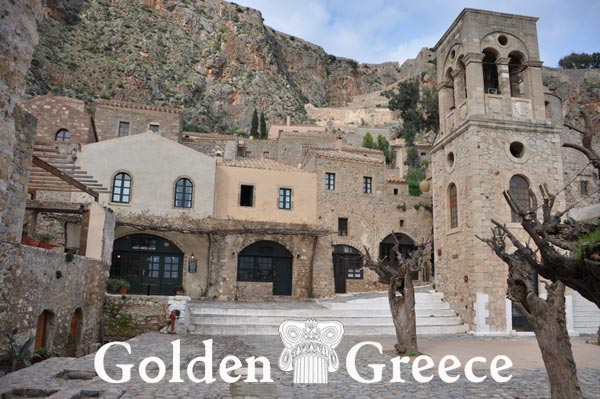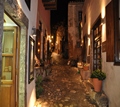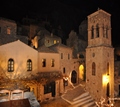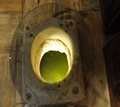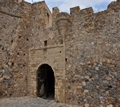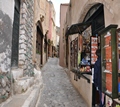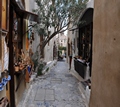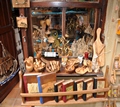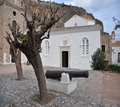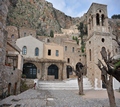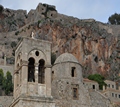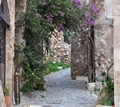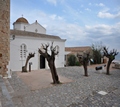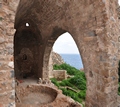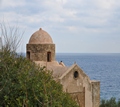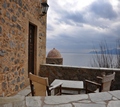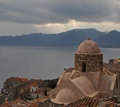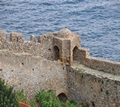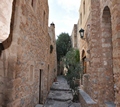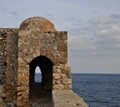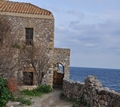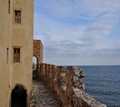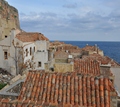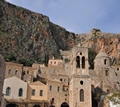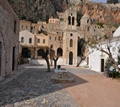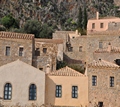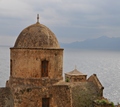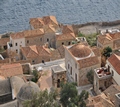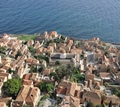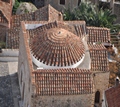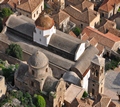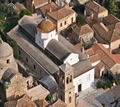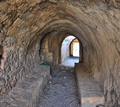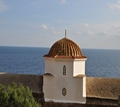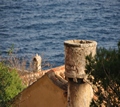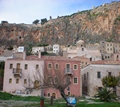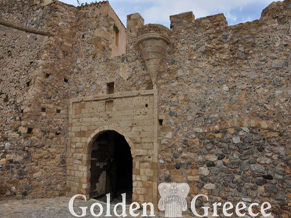
During Middle Byzantine times, the physical fortification of a settlement's location is the most basic selection criterion for its creation.
Thus, the Lower City began to be created on the SE coast of the island shortly after 900 AD, about 300 years after the date of construction of Monemvasia.
The Lower City of Monemvasia is a typical example of a Byzantine commonwealth.
It is crossed by two vertical streets, which end at its four gates.
The current Central Gate is located on the Western wall of the Lower City. North of this gate, near the rock, the second gate opens. Two more gates, of smaller dimensions, open on the eastern and southern wall, towards the sea. The southern one is called Portello and served the city's communication with the sea.
The streets of the Lower Town are narrow and paved with stone (cobblestones), while their width varies according to the available space. The steep slope of the ground also dictated the creation of stairs. Some parts of the streets are covered by arches that are called roadways or thoroughfares. Above them, due to lack of space, floors of houses are being developed.
As for water, this was also a key criterion for the creation of the city during the Byzantine period. However, Monemvasia and its hinterland do not have natural water reserves or rivers. Their lack leads to the creation of a water supply system, so that the residents' water needs are covered by the creation of private and public cisterns. Collection of rainwater was also achieved by the special configuration of the roofs and the extended, gutter-like sloping gables of the buildings.
In the settlement of Kato Polis, which is still inhabited today, the ruined buildings are being restored under the supervision of the Archaeological Service. The city is surrounded by a U-shaped protective wall, with two gates on the east and west and a small exit to the sea.
Inside the city, public buildings, churches and private houses are being developed. These are built next to each other due to lack of space. In the Lower Town, the main church buildings have been preserved and there are the following churches:
Elkomenos Christos:
Three-aisled vaulted basilica with a dome and narthex, a built choir and episcopal throne.
The Attracted Christ is the largest church in Monemvasia, which also impresses with the stone bell tower next to it. It is a beautiful three-aisled basilica with a dome which has received several additions to the narthex, pronaos and iconostasis. It was converted into a mosque during the period of A; Ottoman period [middle of the 16th - end of the 17th (1540-1690)], during the 2nd Venetian rule it was turned into an institution of Catholic monks, while during the 2nd In the Ottoman period it was again converted into a mosque. The church preserves important images from post-Byzantine times inside.
Muslim Mosque
Building of the First Ottoman Empire (16th century) which was converted into a Frankish church in the Venetian Empire, to become a mosque again in the 18th century. It has been preserved and houses the Archaeological Collection.
Church of Panagia Myrtidiotissa
Single-aisled basilica with a dome, built around 1700. The interior was decorated with a wood-carved iconostasis.
Church of Agios Nikolaos
Three-aisled vaulted basilica with a dome, from 1703.
Church of Panagia Chrysafitissa
Square hall covered entirely with a low dome, 17th century.
In the Lower City there are other smaller churches such as Agios Andreas, Agia Anna the Catholic, Agia Anna from the years of the Second Venetian Empire (1690-1720) and Agios Dimitrios.
Editor: Fotini Anastasopoulou






